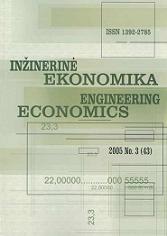FDI and the Transformation from Industry to Service Society in Emerging Economies: A Lithuanian - Nordic Perspective
FDI and the Transformation from Industry to Service Society in Emerging Economies: A Lithuanian - Nordic Perspective
Author(s): Gediminas Ramanauskas, Rolv Petter Amdam, Randi LunnanSubject(s): Economy
Published by: Kauno Technologijos Universitetas
Keywords: foreign direct investment; emerging economies; clusters
Summary/Abstract: Globally, the period from the 1980s to 2006 was characterised by growth in FDIs. Except for 1991, FDI flows increased every year between 1986 and 2000. The period was also characterized by high economic growth in the so-called emerging economies. These economies became strongly involved in the global economy in this period through an increase in inward FDIs. In some emerging economies, like China and the Baltic states inward FDIs increased even after the general setback in 2001. For example, while FDI inflows globally fell by 41 percent in 2001, and another 21 percent in 2002, it in-creased with 18 percent in 2001 and another 64 percent in 2002 in Lithuania (UNCTAD, 2003). These tendencies ask for a closer examination of the role of FDIs in the recent development of emerging economies. The paper deals with the role of MNEs and FDI in emerging economies from about 1990 by especially fo-cusing on Norwegian FDIs in Lithuania.1 This case is special because of two reasons. First, not only is Lithua-nia an example of a new emerging economy. Norway is also an example of a newcomer as a foreign investor, compared to many other industrial countries. It was not only until the mid-1980s that outward FDIs from Norway began to increase substantially (UNCTAD, 2004b), and before 1980 there were only few Norwegian companies that could be characterized as multinationals (Amdam and Hagberg, 2001). Over the last 20 years some Nor-wegain companies have developed into multinationals, among them Statoil and RIMI were among the largest foreign investors in Lithuania in 2006 . Second, the rela-tionship between Norway and Lithuania is of a special kind, since the two countries belong to a greater Nordic-Baltic region with strong cultural, political, and not at least economic relationship for centuries (Scandinavian Journal of History, 2003). They both were attached to the Hanseatic league, an informal collaboration from about 1380 to the beginning of the 17th century between trade cities gathered around the Baltic sea and extending the reach of the league as far as London, Bergen (Norway) and Novgorod (Russia).
Journal: Engineering Economics
- Issue Year: 2007
- Issue No: 1 (51)
- Page Range: 22-28
- Page Count: 7
- Language: English

